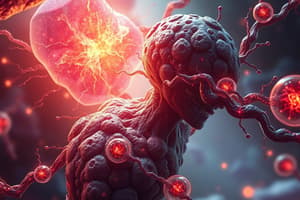Podcast
Questions and Answers
What is metabolism?
What is metabolism?
- The energy available for release in a chemical reaction
- The study of energy transformations
- A metabolic process that consumes energy
- The total of an organism's chemical reactions (correct)
What is a metabolic pathway?
What is a metabolic pathway?
A series of defined steps that alter a specific molecule, resulting in a specific product.
What does a catabolic pathway do?
What does a catabolic pathway do?
Breaks down complex molecules into simpler compounds.
What is an anabolic pathway?
What is an anabolic pathway?
What is bioenergetics?
What is bioenergetics?
Define kinetic energy.
Define kinetic energy.
Define heat energy.
Define heat energy.
Define potential energy.
Define potential energy.
What is chemical energy?
What is chemical energy?
What does the first law of thermodynamics state?
What does the first law of thermodynamics state?
What does the second law of thermodynamics state?
What does the second law of thermodynamics state?
What is free energy?
What is free energy?
What does enzyme refer to?
What does enzyme refer to?
Define activation energy.
Define activation energy.
What is the enzyme-substrate complex?
What is the enzyme-substrate complex?
Define allosteric regulation.
Define allosteric regulation.
A +G coupled with an exergonic reaction and with the addition of a catalyst ____________ the reaction.
A +G coupled with an exergonic reaction and with the addition of a catalyst ____________ the reaction.
A -G with no addition of a catalyst ________________ the reaction.
A -G with no addition of a catalyst ________________ the reaction.
A +G without a coupled reaction and without a catalyst ________________ the reaction.
A +G without a coupled reaction and without a catalyst ________________ the reaction.
What is cooperativity in enzyme activity?
What is cooperativity in enzyme activity?
What causes feedback inhibition in metabolic pathways?
What causes feedback inhibition in metabolic pathways?
Where are enzymes for cellular respiration found?
Where are enzymes for cellular respiration found?
What does the lock-and-key model of enzymes suggest?
What does the lock-and-key model of enzymes suggest?
What is the optimal temperature range for enzymes in the human body?
What is the optimal temperature range for enzymes in the human body?
What is the optimal pH range for enzymes in the human body?
What is the optimal pH range for enzymes in the human body?
Flashcards are hidden until you start studying
Study Notes
Metabolism Overview
- Metabolism encompasses all chemical reactions in an organism, showcasing life through molecular interactions in cellular environments.
- Metabolic pathways are sequences of reactions starting with a specific molecule, which is transformed through defined steps by specific enzymes, culminating in a particular product.
Catabolic and Anabolic Pathways
- Catabolic pathways break down complex molecules into simpler compounds, releasing energy; cellular respiration exemplifies this by converting glucose into carbon dioxide and water.
- Anabolic pathways utilize energy to construct complex molecules from simpler ones, such as synthesizing proteins from amino acids, leveraging energy sourced from catabolic processes.
Energy Concepts
- Bioenergetics studies energy flow in organisms, with energy defined as the capacity to initiate change.
- Kinetic energy relates to an object's motion; potential energy refers to energy due to an object's position or structure.
- Chemical energy, a type of potential energy, is available for release in chemical reactions, notably high in glucose.
Thermodynamics Principles
- Thermodynamics examines energy transformation; the first law asserts energy conservation—energy cannot be created or destroyed, only converted.
- The second law states that energy transformations increase entropy, indicating a natural trend towards disorder.
Free Energy and Stability
- Free energy indicates a system's capacity to do work; it is high in unstable systems (+G) and low in stable systems (-G).
- Exergonic reactions release free energy, signified by negative Gibbs free energy, while endergonic reactions absorb energy and are characterized by positive Gibbs free energy.
Cellular Work Types
- Chemical work facilitates non-spontaneous reactions, such as polymer synthesis.
- Transport work involves moving substances across membranes against spontaneous movement.
- Mechanical work relates to movements like muscle contraction and cilia beating.
ATP and Energy Coupling
- ATP, composed of ribose, adenine, and three phosphate groups, serves as the primary energy currency in cells.
- Energy coupling refers to the process where an exergonic reaction drives an endergonic one, with ATP commonly mediating this process.
Enzyme Function and Regulation
- Enzymes act as catalysts, expediting reactions without being consumed; they reduce activation energy required for reactions.
- The activation energy is the energy necessary to initiate biochemical reactions, and the enzyme-substrate complex is formed when an enzyme binds to its substrate at the active site.
- Enzymes can be influenced by inhibitors, which can be competitive (competing with substrates) or noncompetitive (binding elsewhere to alter enzyme shape).
Enzyme Models and Reactions
- The lock-and-key model describes enzyme specificity, while the induced fit model illustrates how enzymes and substrates shape each other for optimal interaction.
- Feedback inhibition regulates metabolic pathways, where end products inhibit early enzymes to conserve resources.
Environmental Effects on Enzymes
- Optimal conditions for enzyme activity include a temperature range of 35-40°C and a pH range of 6-8, crucial for maintaining enzymatic function in the human body.
Summary of Key Reactions and Energies
- Hydrolysis of ATP (ATP → ADP + P(i)) releases -7.3 kcal/mol of energy, while synthesis (ADP + P(i) → ATP + H2O) requires +7.3 kcal/mol.
- Aerobic cellular respiration (C6H12O6 + 6O2 → 6CO2 + 6H2O) releases -686 kcal/mol of Gibbs free energy.
Additional Terms
- Entropy reflects disorder in a system; enthalpy indicates order.
- Saturation in enzymes occurs when products are promptly replaced by new substrates.
- Cofactors assist enzymes in reactions; coenzymes, typically vitamins, are inorganic cofactors.
Studying That Suits You
Use AI to generate personalized quizzes and flashcards to suit your learning preferences.




